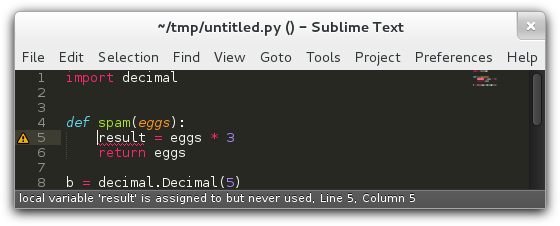Python Checker
A maintainable Python code checker for Sublime Text 3
Details
Installs
- Total 86K
- Win 48K
- Mac 16K
- Linux 22K
| Dec 28 | Dec 27 | Dec 26 | Dec 25 | Dec 24 | Dec 23 | Dec 22 | Dec 21 | Dec 20 | Dec 19 | Dec 18 | Dec 17 | Dec 16 | Dec 15 | Dec 14 | Dec 13 | Dec 12 | Dec 11 | Dec 10 | Dec 9 | Dec 8 | Dec 7 | Dec 6 | Dec 5 | Dec 4 | Dec 3 | Dec 2 | Dec 1 | Nov 30 | Nov 29 | Nov 28 | Nov 27 | Nov 26 | Nov 25 | Nov 24 | Nov 23 | Nov 22 | Nov 21 | Nov 20 | Nov 19 | Nov 18 | Nov 17 | Nov 16 | Nov 15 | Nov 14 | Nov 13 | |
|---|---|---|---|---|---|---|---|---|---|---|---|---|---|---|---|---|---|---|---|---|---|---|---|---|---|---|---|---|---|---|---|---|---|---|---|---|---|---|---|---|---|---|---|---|---|---|
| Windows | 1 | 2 | 0 | 2 | 2 | 2 | 5 | 2 | 2 | 4 | 0 | 3 | 4 | 2 | 2 | 2 | 2 | 2 | 4 | 2 | 4 | 0 | 0 | 1 | 2 | 0 | 3 | 0 | 0 | 0 | 2 | 2 | 4 | 3 | 2 | 5 | 0 | 1 | 3 | 9 | 4 | 2 | 3 | 2 | 3 | 1 |
| Mac | 0 | 1 | 0 | 0 | 0 | 1 | 0 | 0 | 0 | 0 | 1 | 4 | 0 | 0 | 0 | 0 | 0 | 0 | 0 | 0 | 2 | 0 | 0 | 0 | 0 | 1 | 0 | 1 | 0 | 0 | 0 | 0 | 0 | 1 | 0 | 0 | 0 | 0 | 2 | 1 | 0 | 0 | 0 | 0 | 0 | 1 |
| Linux | 1 | 0 | 0 | 0 | 0 | 1 | 3 | 0 | 0 | 0 | 0 | 1 | 2 | 0 | 3 | 1 | 2 | 0 | 0 | 2 | 1 | 0 | 0 | 1 | 0 | 3 | 2 | 0 | 0 | 1 | 1 | 0 | 1 | 2 | 0 | 0 | 0 | 2 | 1 | 2 | 4 | 2 | 1 | 2 | 0 | 0 |
Readme
- Source
- raw.githubusercontent.com
Python Checker
A maintainable Python code checker for Sublime Text 3

Once the plugin is installed, it will highlight common problems in your Python code.
Internally it relies on the wonderful pyflakes and pep8 packages.
Installation
Use Package Control.
Python version
By default Python Checker will use the version of Python that came with Sublime Text 3. This currently means Python 3 and can result in problems like undefined name 'unicode' being reported. If you want to use a different version, set the python_interpreter_path option in your project settings:
# <project name>.sublime-project
{
"settings": {
"python_interpreter_path": "/usr/bin/python"
}
}
This is compatible with other plugins including SublimeJEDI.
PEP8 checks
Use the standard pep8 configuration files to control the behaviour including skipping some checks. An example project configration might look like this:
# setup.cfg or tox.ini
[pep8]
ignore = E501,W191
max-line-length = 120
